Background
The COVID-19 pandemic moved into the United States in January 2020 and by March, it had gained momentum (CDC, 2020; WHO, 2020). Over a very short time span, organizations were forced to respond to changing public health conditions.
In Illinois, the first COVID-19 stay-at-home order became effective on March 21 (Pritzker, 2020). This effective date hit either during or near the time that many higher education institutions had spring break. Therefore, after the break, most classes in all modalities were mandated to take place in a virtual setting. The research in this pandemic is quickly evolving as our colleagues in education seek to share value-added information to the field and to measure the impact of the switch from face-to-face to online learning.
During February-May, there was an onslaught of industry-written content posted to online periodicals and industry associations suggesting best practices for online learning. As institutions quickly switched from their traditional methods of teaching to an all virtual platform, there was much advice from industry experts and non-experts on how to teach online; how to post lecture materials; and more. Much of the early advice was about how to transition real-time, in-person teaching to real-time, virtual teaching (Darby, 2020). It soon became clear that “emergency remote learning” was not the same as online learning (Shisley, 2020). Experienced online instructors know there are other ways to successfully teach online, and the asynchronous model is one that has been adopted and researched for decades by many institutions of higher education (Darby, 2020).
The students in this study were asynchronous online students before and after spring break, so their modality of instruction did not change due to the COVID-19 crisis. Studying students’ challenges in courses built for online learning provided a unique opportunity to view the students’ needs in crisis without the added factor of changing instructional modality.
It is conjectured that most individuals at this time experienced some changes in circumstances. This research is supported with data about students’ barriers and challenges to success in learning. Researchers also reviewed data on how the institution can support students during and following the crisis. The data are presented to provide insight for institutions to use to support students in the future as the COVID-19 crisis develops into new stages or for future unknown crisis situations.
Methodology
This research-based approach reviewed secondary data from course evaluations for asynchronous online courses taught in the spring 2020 semester at a small, liberal arts institution located in Illinois. The six graduate and six undergraduate courses were chosen by professors teaching asynchronously, online for the entire semester (pre- and post-COVID-19 emergency switch to online). The courses were in the areas of healthcare administration and business. Five full-time faculty members with extensive experience in the online asynchronous learning environment voluntarily added three questions related to the COVID-19 emergency to their course evaluations.
The research questions were: What were the students’ biggest challenge during the crisis semester? What could the institution do going forward to help the students during the crisis? What barriers to success did students’ experience?
The qualitative data were reviewed using IBM’s Statistical Package for the Social Sciences (SPSS) Text Analysis software. The software provides coding capability and uses advanced linguistic technologies to organize the data into categories and links associations between the constructs. After an initial coding of terms, the researcher then attributes a coding analysis to like-terms.
Results
First, students were asked about their biggest challenge during the semester. There were 75 total responses reviewed in this data set. The strongest relationships were in the areas of academics and work. In the second tier of challenges with academics and work were time and family/friends. Weaker challenges were financial, health, changes, and external issues. Stress and concern also ranked in the lower half of the data sample for this research question.
The figures presented provide a visual web view of the categorical relationships. Stronger relationships are indicated by a dark thick line and weaker relationships have a thin line. No line indicates little to no relationship. The tables provide the text analysis categories ranked highest to lowest. The selection percentage is the percentage of respondents who were coded in a particular category.
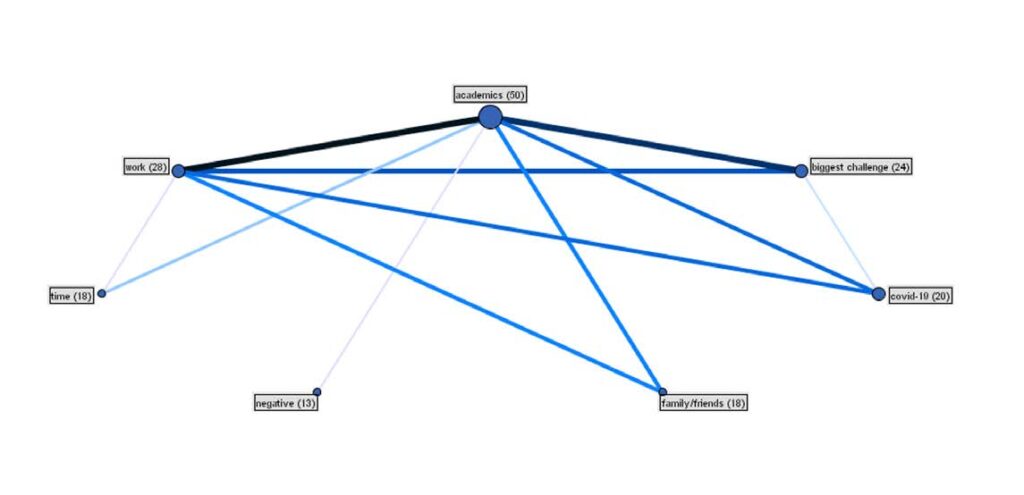
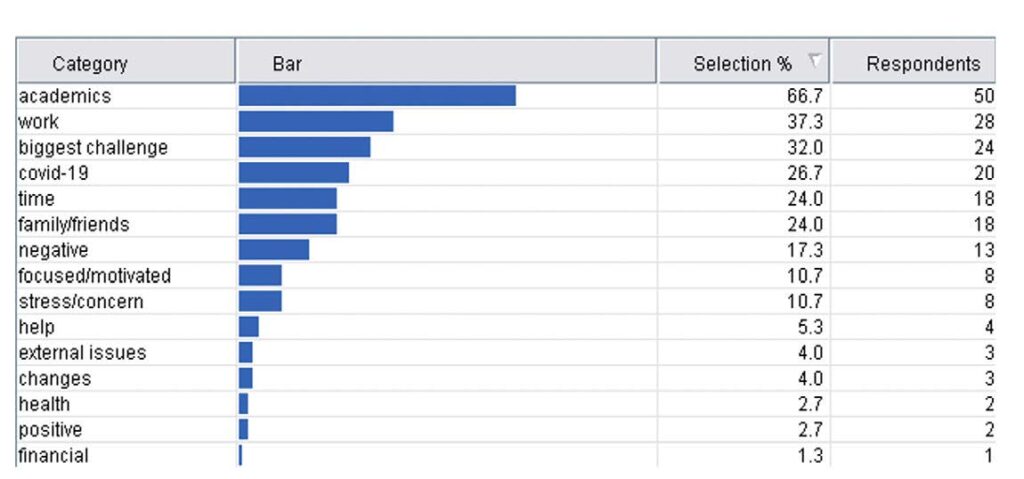
Secondly, students were asked about how the institution can support them during and following the crisis. There were 55 total responses reviewed in this data set. The strongest relationships were between help/support and academics. Relationships included: positive with university and academics, positive with faculty, and academics with faculty. Weaker areas of support were in the areas of focus, imbalance, feelings, communities, events, leader, and staff.
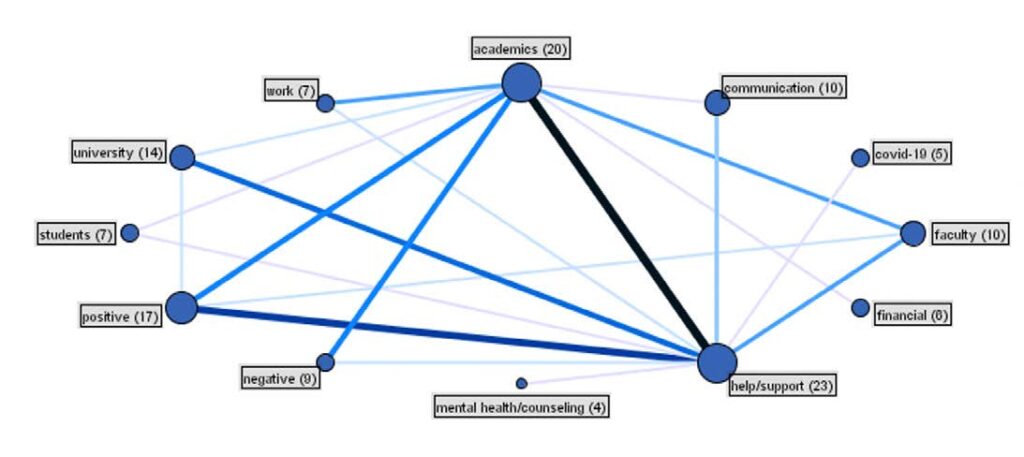
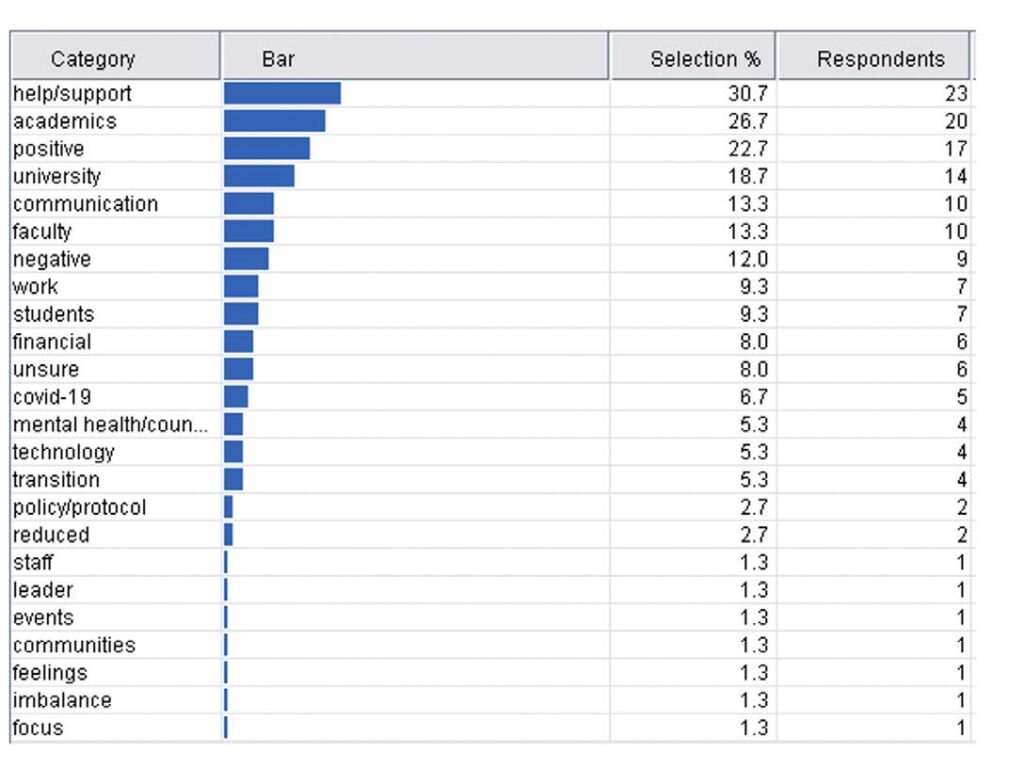
Finally, students were asked about their barriers to success during this time period. There were 65 total responses reviewed in this data set. The strongest relationships were between psychological, academics, and work-employment. Other relationships included:
- Psychological, work/employment, and negative
- Psychological, work/employment, and family/friends
- Academics, work/employment, and time
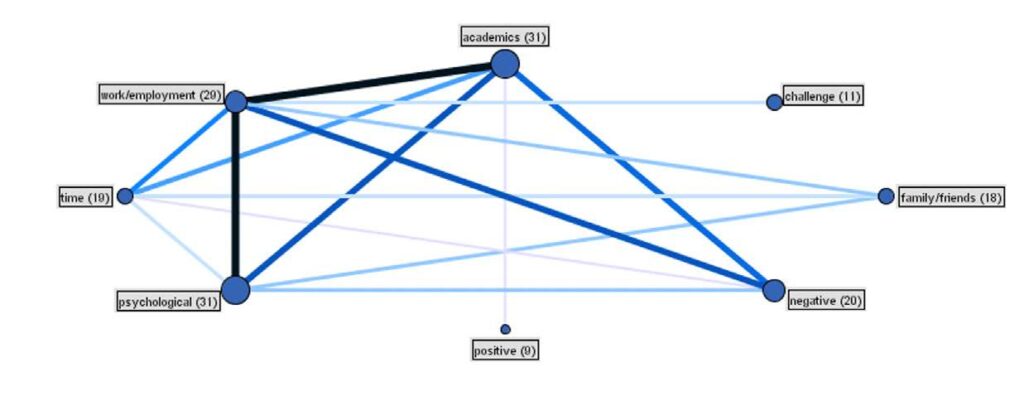
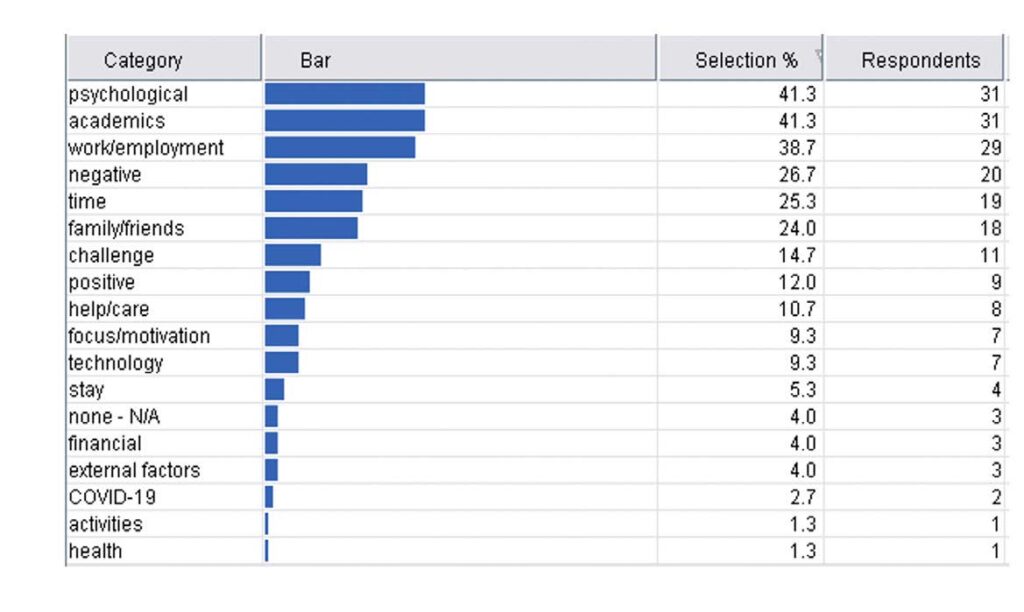
Discussion
The findings demonstrate that for these asynchronous online students, there were challenges due to COVID-19 in the areas of academics and work. Surprising to the researchers was that both financial and health concerns ranked in the lowest categories. One of the comments in this category stated:
My biggest challenge has been balancing work, school, the kids, and their remote learning due to COVID-19. I am currently trying to find time to teach my second grader all things rainforest and cursive (along with all other subjects) in the few hours I have before their bedtime.
Perhaps financial and health concerns were not as critical since the need to balance work and home consumed extra time. The students’ job type may have fallen into one that was critical during this timeframe. Frontline workers during the COVID-19 pandemic included individuals who could not work from home, many of whom also lost childcare support services (Blau, Koebe, Meyerhofer, 2020). This included “healthcare workers, protective service workers (police and EMTs), cashiers in grocery and general merchandise stores, production and food processing workers, janitors and maintenance workers, agricultural workers, and truck drivers” (Blau, Koebe, Meyerhofer, 2020). These job categories may have matched the students involved in this study.
The findings also link challenges, academics, work with time and family/friends. Even though these students did not change modalities in their academic studies, the impact of time and family/friends was clear. One of the comments in this category stated:
My biggest challenge this semester was getting through the semester with all that is happening in the world, with home & family and work.
Again, the idea of balance is a theme that impacted students’ ability to focus on academics.
In the area of help and support, the data demonstrated that academics was the strongest relationship for areas of support. In general, the students had positive comments about the support they received, but this could be an area of continued focus as institutions proactively plan for future semesters that may continue to be impacted by new public health policies and procedures. One of the comments in this category stated:
I was thankful to [the institution] for working with our class, for being accommodating and to our Professor who was very helpful and informative.
The students point to the idea of flexibility in the area of support. Another student used the word “lenience” when “dealing with unexpected transitions” and attributed this to the idea of comfort.
The data also support the important role of faculty in the area of help and support. The faculty members were on the front line in the academic online classroom, so it is quite possible that students looked to the faculty members for the areas where they were in need. Surprising to the researchers was that focus, imbalance, and feelings were not ranked highly by the students. In addition, while mental health was mentioned in the results for challenges, it is not ranked in the top categories for this question. However, when reviewing the data for barriers to success, students listed various psychological and academics as the two top categories. This may be a result of students experiencing these barriers, but finding other resources to support them rather than feeling the need to seek these resources from the university.
Conclusions and Implications to Practice
While this study was limited in scope, it does provide critical insight and data to demonstrate the impact of the COVID-19 crisis on a body of students. As institutions make plans for future semesters where COVID-19 issues will likely still be present, additional emphasis could be placed on student support for asynchronous online courses. Faculty can offer flexibility, presence, and compassion. Institutional resources such as libraries, academic support, and counseling can also support student learning.
References
Blau, F. D., Koebe, J., & Meyerhofer, P. A. (2020, April 30). Essential and frontline workers in the COVID-10 crisis. Econofact. Retrieved from: https://econofact.org/essential-and-frontline-workers-in-the-covid-19-crisis
Centers for Disease Control and Prevention (CDC) (2020). COVID-19 pandemic planning scenarios. https://www.cdc.gov/COVID-19/2019-ncov/hcp/planning-scenarios.html
Darby, F. (2020, April 14). 5 low-tech, time-saving ways to teach online during covid-19. The Chronicle of Higher Education. Retrieved from: https://www.chronicle.com/article/5-Low-Tech-Time-Saving-Ways/248519
Pritzker, J.B. (2020, March 20). COVID-19 Executive order No. 8. Office of the Governor, Illinois.gov. Retrieved from: https://www2.illinois.gov/IISNews/21288-Gov._Pritzker_Stay_at_Home_Order.pdf
Shisley, S. (2020, May 20). Emergency remote learning compared to online learning. Learning Solutions. Retrieved from: https://learningsolutionsmag.com/articles/emergency-remote-learning-compared-to-online-learning
World Health Organization (WHO). (2020, January 23). Novel COVID-19 (2019-nCoV) situation report-3. Retrieved from: https://www.who.int/docs/default-source/COVID-19e/situation-reports/20200123-sitrep-3-2019-ncov.pdf?sfvrsn=d6d23643_8
